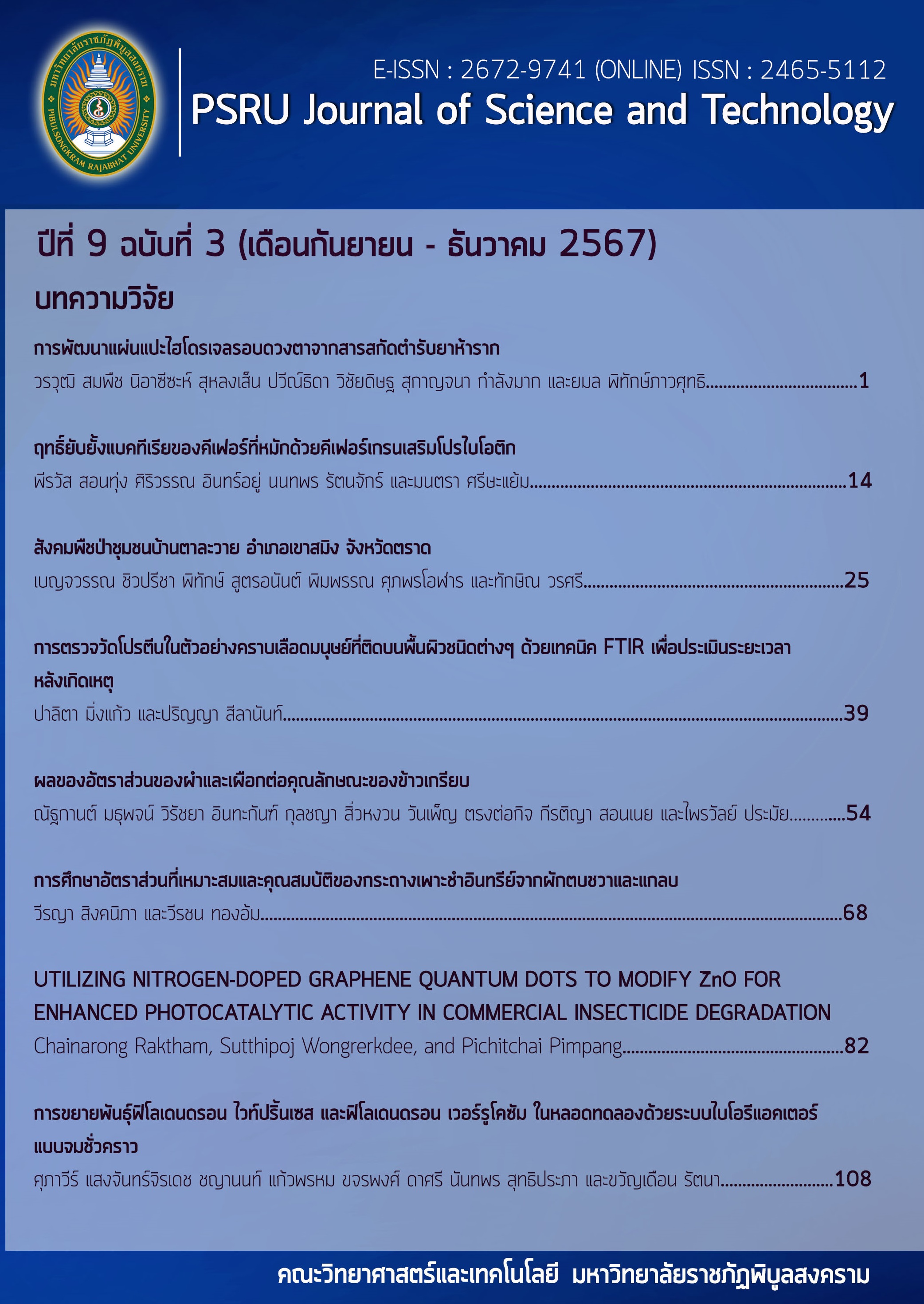UTILIZING NITROGEN-DOPED GRAPHENE QUANTUM DOTS TO MODIFY ZnO FOR ENHANCED PHOTOCATALYTIC ACTIVITY IN COMMERCIAL INSECTICIDE DEGRADATION
คำสำคัญ:
Nitrogen-doped graphene quantum dots, Nitrogen doping effects, Photocatalytic performance, Insecticide degradation, Sustainable water treatmentบทคัดย่อ
This study investigates the synthesis and application of nitrogen-doped graphene quantum dots (N-GQDs) for enhancing the photocatalytic activity of ZnO in the degradation of insecticide in water. N-GQDs were synthesized via a hydrothermal method using varying nitrogen percentages in citric acid (ranging from 0% to 0.75%), reveal consistent excitation and emission peaks at 350 nm and 440 nm, respectively. Fluorescence characterization indicates that higher nitrogen doping percentages enhance the fluorescence intensity of N-GQDs, suggesting increased photo-generated electron production. FT-IR spectra confirm successful nitrogen doping, with characteristic peaks at 1345 cm⁻¹ attributed to C-N stretching vibrations. Furthermore, UV-V is spectroscopy was employed to analyze the absorbance spectra of
a commercial insecticide (beta-cyfluthrin) in water (concentrations: 100-500 ppm), demonstrating a linear increase in integrated absorbance value with concentration. This underscores the potential of UV-Vis spectroscopy for precise insecticide quantification. Photocatalytic degradation experiments using N-GQD-modified ZnO catalysts showed reduced residual insecticide integrated absorbance value compared to pristine ZnO and GQD-modified ZnO, highlighting enhanced photocatalytic activity of N-GQDs. Photocatalytic degradation experiments indicated that ZnO modified with N-GQDs was more effective than ZnO and ZnO modified with GQDs, with the optimal nitrogen doping level found to be 0.65%. This result demonstrates the potential of nitrogen-doped graphene quantum dots as effective photocatalysts for environmental remediation applications.
References
Batvandi, M., Haghighatzadeh, A., Mazinani, B., & Dutta, J. (2022). Visible-light-driven photocatalysis with Z-scheme Ag3PO4@N-GQDs@g-C3N4 nano/hetero-junctions. Applied Physics A, 128, 853.
Dong, F., Zhao, Z., & Xiong, T. (2016). In situ construction of g-C3N4/g- C3N4 metal-free heterojunction for enhanced visible light photocatalysis. Science Reports, 6, 22902.
Hameed, A.S., Mohamed, S.A., & Kadi, M.W. (2019). ZnO-based nanomaterials for environmental applications: A review. Journal of Environmental Chemical Engineering, 7(5), 103196.
Huo, P., Shi, X., Zhang, W., Kumar, P., & Liu, B. (2021). An overview on the incorporation of graphene quantum dots on TiO2 for enhanced performances. Journal of Materials Science, 56, 6031–6051.
Kaur, M., & Singh, V. (2020). Recent advances in the modification of ZnO for efficient photocatalytic degradation of organic pollutants. Environmental Chemistry Letters, 18(1), 241-260.
Krobthong, S., Wongrerkdee, S., Pimpang, P., Moungsrijun, S., Sujinnapram, S., Nilphai, S., Rungsawang, T., & Wongrerkdee, S. (2022). ZnO Nanoparticles Coprecipitation with Aluminum and Copper Ions for Efficient Photocatalytic Degradation of Commercial Glyphosate. Integrated Ferroelectrics, 222(1), 69-83.
Li, L., Li, L., Wang, C., Liu, K., Zhu, R., Qiang, H., & Lin, Y. (2015). Synthesis of nitrogen-doped and amino acid-functionalized graphene quantum dots from glycine, and their application to the fluorometric determination of ferric ion. Microchim Acta, 182(3–4),763–770.
Ong, W.J., Tan, L.L., Ng, Y.H., Yong, S.T., & Chai, S.P. (2016). Graphitic carbon nitride (g-C3N4)-based photocatalysts for artificial photosynthesis and environmental remediation: Are we a step closer to achieving sustainability? Chemical Reviews, 116(12), 7159-7329.
Pimpang, P., Sumang, R., & Choopun, S. (2018). Effect of Concentration of Citric Acid on Size and Optical Properties of Fluorescence Graphene Quantum Dots prepared by Tuning Carbonization Degree. Chiang Mai Journal of Science, 45(5), 2005-2014.
Pimpang, P., Thong-on, W., & Choopun, S. (2018). Improvement in Acetylene Sensing Properties of Zinc Oxide Nanowires Embedded with Gold Nanoparticles. PSRU Journal of Science and Technology, 3(2), 1-12.
Pimpang, P., & Choopun, S. (2019). UV Sensor based on Zinc Oxide Nanostructures Assisted by Surface Plamon Resonance. PSRU Journal of Science and Technology, 4(2), 11-22.
Phophayu, S., Pimpang, P., Wongrerkdee, S., Sujinnapram, S., & Wongrerkdee, S. (2020). Modified graphene quantum dots-zinc oxide nanocomposites for photocatalytic degradation of organic dyes and commercial herbicide. Journal of Reinforced Plastics and Composites, 39(3-4), 81-94.
Sujinnapram, S., & Wongrerkdee, S. (2023). Synergistic effects of structural, crystalline, and chemical defects on the photocatalytic performance of Y-doped ZnO for carbaryl degradation. Journal of Environmental Sciences, 124, 667-677.
Shen, W., Zhang, K., Zhang, Y., Zheng, D., & Cui, Z. (2019). Enhanced photocatalytic performance of nitrogen-doped graphene quantum dots/ZnO composites for organic pollutant degradation. Journal of Colloid and Interface Science, 552, 232-240.
Wongrerkdee, S., Wongrerkdee, S., Boonruang, C., & Sujinnapram, S. (2022). Enhanced Photocatalytic Degradation of Methylene Blue Using Ti-Doped ZnO Nanoparticles Synthesized by Rapid Combustion. Toxics, 11(1), 33.
Wu, J., Wang, J., & Li, X. (2017). Nitrogen-doped graphene quantum dots/ZnO composite: Characterization and its enhanced photocatalytic activity. Applied Catalysis B: Environmental, 201, 593-601.
Wongrerkdee, S., & Pimpang, P. (2020). Ultraviolet‐Shielding and Water Resistance Properties of Graphene Quantum Dots/Polyvinyl Alcohol Composite-based Film. Journal of Metals, Materials and Minerals, 30(4), 90-96.
Xiang, Q., Yu, J., & Jaroniec, M. (2012). Graphene-based semiconductor photocatalysts. Chemical Society Reviews, 41(2), 782-796.
Zhou, X., Jin, W., Zhao, X., & He, Z. (2018). Enhancing the photocatalytic performance of ZnO nanorods by surface modification with noble metal nanoparticles. Applied Surface Science, 430, 344-352.
Zhu, Y., Ji, H., Zheng, W., & Liu, H. (2021). Nitrogen-doped graphene quantum dots modified ZnO nanorods for enhanced photocatalytic activity. Applied Surface Science, 535, 147620.
Zhang, Y., Li, Y., & Wang, F. (2018). Nitrogen-doped graphene quantum dots/ZnO nanocomposites: Enhanced photocatalytic activity and mechanism. Journal of Alloys and Compounds, 735, 1897-1904.
Downloads
เผยแพร่แล้ว
How to Cite
ฉบับ
บท
License
Copyright (c) 2024 PSRU Journal of Science and Technology

This work is licensed under a Creative Commons Attribution-NonCommercial-NoDerivatives 4.0 International License.
กองบรรณาธิการขอสงวนสิทธิ์ในการปรับปรุงแก้ไขตัวอักษรและคำสะกดต่างๆ ที่ไม่ถูกต้อง และต้นฉบับที่ได้รับการตีพิมพ์ในวารสาร PSRU Journal of Science and Technology ถือเป็นกรรมสิทธิ์ของคณะวิทยาศาสตร์และเทคโนโลยี มหาวิทยาลัยราชภัฏพิบูลสงคราม และ
ผลการพิจารณาคัดเลือกบทความตีพิมพ์ในวารสารให้ถือมติของกองบรรณาธิการเป็นที่สิ้นสุด






